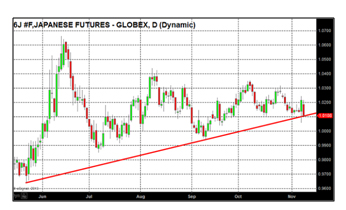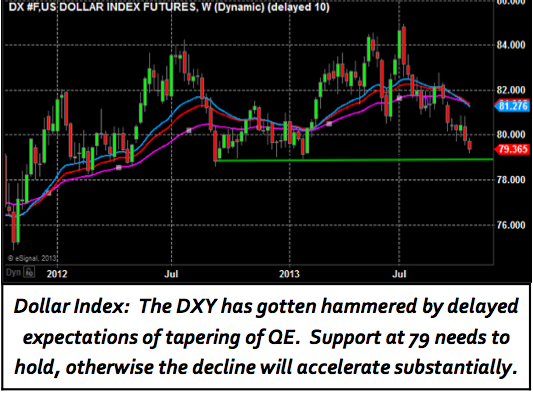Last Week
With the drama in Washington successfully postponed, focus last week turned to the question of “How much damage has the shutdown and drama done to the economy?”
While it’s still early, based on last week’s data, the answer so far is “definitely some” because economic data almost universally missed expectations last week. Perhaps more disconcerting than that, though, were the weak jobs and durable goods reports. These are from September (and pre-shutdown), and they imply that the economy may have been losing momentum before the last round of drama in Washington.
With regard to WWFD (what will the Fed do), the soft data last week further solidified March 2014 as the “consensus” date for the first tapering of QE. However, many analysts think it could come as soon as January, depending on the data. But, from a Fed standpoint, last week was marginally “dovish.”
The September jobs report showed 148K jobs added, with a net 9K positive revision for July and August, which was well-below expectations of 180K. As mentioned, this data was compiled before the shutdown, and the bottom line is that the jobs market remains largely stuck in neutral—adding between 150K and 200K jobs/month, as it has been doing over the past quarter. Progress in the labor market has clearly stalled.
Manufacturing data was also disappointing. October flash manufacturing PMI, which is inclusive of the shutdown, missed expectations. New orders, the leading indicator in the report, fell to a multi-month low. Although, importantly, the PMI did stay above 50—signaling continued expansion in the manufacturing sector—the pace of that expansion is slowing.
On Friday, the September durable goods report was also weak. The headline number was a beat, but as always with durable goods, you can ignore the headline and instead look at the “New Orders for Non-Defense Capital Goods Excluding Aircraft.” NDCGXA fell 1.1% in September (so, before the shutdown). This will raise some concerns that businesses are now starting to reduce spending and investment amidst all this uncertainty, which puts our 2% growth rate at risk.
Bottom line is the economy remains a major concern, and also the single-most-important catalyst for higher stock prices. (More QE won’t make the market go substantially higher; we need real economic growth.)
Interestingly, the stock market didn’t sell off in reaction to last week’s data, and that’s because it’s impossible to try and figure out how much of the weakness in the economic data was just temporary (because of the shutdown) and what was more structural.
And, we can expect the market to continue to largely “ignore” weak data for the next few weeks, given the noise from the shutdown.
The economy returning to above-trend growth (meaning 3%-plus) remains the key to substantially higher equity prices. If the data stays soft into December, the dynamic in the market will change, and not for the better.
This Week
This week’s highlight is undoubtedly the FOMC meeting Tuesday/Wednesday. I’ll give a more in-depth preview of what’s expected, but at this point no one expects any tapering of QE, and in all likelihood this should be a relative non-event.
I would expect the Fed’s commentary on the economy will be downgraded given the government shutdown, and on balance the risk is that the meeting is perceived as “dovish.” But really, the only thing that people are trying to figure out is when will the Fed first taper. Given the data, it looks like the answer is “not in 2013.”
Away from the Fed, we get several key economic reports. These will be watched, but don’t expect the market to necessarily trade off them like we’d normally see, given the “noise” in the data and all that’s happened in the economy since September.
We get more insight into the state of the manufacturing industry with industrial production this morning and the final Institute for Supply Management’s manufacturing PMIs Friday. In light of the soft durable goods report (and flash PMI), these pieces of data will be watched to see if they confirm the slowing growth we’ve seen in other recent manufacturing and business investment reports.
On the consumer side, September retail sales will be released tomorrow morning. Recent data have implied consumer spending is slowing a bit, but consumer confidence readings in the wake of the shutdown have plunged lately.
This will keep concerns high that the consumer might materially slow down as we approach the holiday season. It hasn’t happened yet, but that’s a legitimate concern for the market, because as the American consumer goes, so goes the U.S. economy.
Finally, this week would normally be “jobs week” but because of the shutdown, the October jobs report has been delayed till next week. But, we do get the ADP jobs report Wednesday, so look for that number to potentially move markets more so than normal. That release will include the period of the October shutdown, and will offer a preview of how much damage was done to the labor market by the shutdown.




